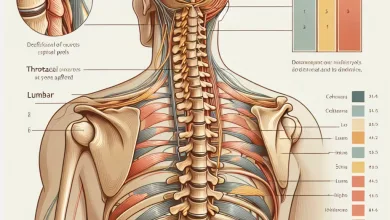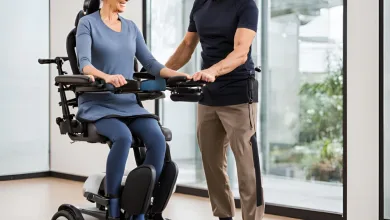How Wheelchairs Support Various Disabilities

Table of Contents
Wheelchairs for Diverse Disabilities: Comprehensive Guide
How Wheelchairs Support Various Disabilities: Wheelchairs provide essential mobility and independence for individuals with various disabilities, adapting to specific needs such as those caused by ALS, MS, and Spinal Cord Injuries. This is the reality that wheelchairs create for countless people.
This blog post dives into the diverse range of disabilities that can benefit from a wheelchair. We’ll explore how these essential tools empower individuals with various conditions to live fully.
Beyond Stereotypes: A World of Reasons for Using a Wheelchair
While wheelchairs are often associated with spinal cord injuries, the reality is much broader. Here are some of the most common disabilities that can necessitate a wheelchair:
- Spinal Cord Injuries (SCI): Damage to the spinal cord can affect mobility, making a wheelchair crucial for daily activities.
- Amputations: The loss of limbs can significantly impact movement, and a wheelchair provides a safe and efficient way to get around.
- Multiple Sclerosis (MS): This neurological condition can cause muscle weakness, fatigue, and balance problems, making a wheelchair a valuable tool for managing daily life.
- Cerebral Palsy (CP): CP affects muscle coordination and movement. Wheelchairs offer support and stability for individuals with CP.
- Muscular Dystrophy: This group of muscle diseases causes progressive weakness. Wheelchairs can help maintain independence for those affected.
- Traumatic Brain Injury (TBI): A TBI can lead to a variety of challenges, including mobility issues. A wheelchair can provide necessary support and improve quality of life.
- Rheumatoid Arthritis (RA): This autoimmune disease causes pain, stiffness, and joint damage, making walking difficult. Wheelchairs offer relief and increased mobility for individuals with RA.
- Scoliosis: Severe spinal curvature caused by scoliosis can significantly impact mobility. Wheelchairs can provide support and improve daily function.
- Spina Bifida: This congenital disability affects the development of the spinal cord and nerves, often leading to paralysis in the legs. Wheelchairs are essential for individuals with spina bifida.
- Alzheimer’s Disease: In later stages, Alzheimer’s can affect balance and coordination, making a wheelchair a safety measure to prevent falls.
- Parkinson’s Disease: This neurological condition can cause tremors, stiffness, and difficulty walking. Wheelchairs can improve mobility and independence for individuals with Parkinson’s.
- Diabetes: In severe cases, Diabetes can lead to nerve damage and foot problems, making walking difficult or painful. Wheelchairs can offer a safe and comfortable alternative.
Remember: This list is not exhaustive. Many other disabilities can benefit from the freedom and independence a wheelchair provides.
The Power of Mobility: How Wheelchairs Enhance Lives
Wheelchairs are more than just transportation modes; they are empowerment tools. Here’s how they can transform lives:
- Increased Independence: Wheelchairs allow individuals with mobility limitations to participate in daily activities, work, and social events without relying on others.
- Improved Quality of Life: The ability to move freely can lead to more significant social interaction, a more active lifestyle, and a higher sense of self-esteem.
- Reduced Pain and Fatigue: For individuals with chronic pain or fatigue, wheelchairs can help conserve energy and minimize discomfort while performing daily tasks.
- Greater Safety: Wheelchairs can prevent falls and injuries for those with balance problems or limited mobility.
Beyond the Wheelchair: A Look at Additional Support Systems
While wheelchairs are incredibly empowering, they are often part of a more extensive support system for individuals with disabilities. Here are some additional considerations:
- Occupational Therapy: Occupational therapists can help individuals learn how to use their wheelchairs effectively and perform daily activities more efficiently.
- Physical Therapy: Physical therapy programs can help improve strength, flexibility, and balance, potentially improving mobility and reducing reliance on a wheelchair in some cases.
- Adaptive Equipment: Tools like grab bars, raised toilet seats, and reachers can make daily living more accessible for individuals with various disabilities.
- Accessible Homes and Communities: Accessible living spaces and public areas with ramps, wider doorways, and lowered counters are crucial for promoting independence.
Working Together: By combining wheelchairs with other support systems and advocating for accessible environments, we can create a world where individuals with disabilities can thrive.
Living a Fulfilling Life with a Wheelchair: Embracing Possibility
Using a wheelchair doesn’t diminish your ability to live a vibrant and fulfilling life. Here are some tips for embracing your newfound freedom:
- Explore Your Options: A variety of wheelchair accessories can enhance your experience. Consider joystick controls, headrests, lap trays, and cup holders for added comfort and functionality.
- Join the Community: Connect with other wheelchair users online or in your local area. Sharing experiences and forming friendships can be incredibly rewarding.
- Advocate for Yourself: Speak up for your needs and accessibility rights. Don’t hesitate to ask for assistance or modifications to create a more inclusive environment.
- Focus on Your Abilities: Don’t define yourself by your disability. Focus on your strengths and talents, and pursue your passions with confidence.
- Stay Active: Regular exercise is crucial for everyone, and wheelchair users are no exception. Explore adapted sports programs or activities like hand cycling or wheelchair basketball.
Remember: A wheelchair is a tool that empowers you to live life on your own terms. Embrace the possibilities and create a future filled with purpose and adventure!
Conclusion: Wheelchairs – Empowering Individuals, Transforming Lives
Wheelchairs are more than just mobility aids; they are symbols of freedom, independence, and a chance to live a fulfilling life. By understanding the diverse range of disabilities that benefit from wheelchairs and their positive impact on individuals’ lives, we can create a more inclusive and supportive world for everyone.
So, the next time you see someone using a wheelchair, remember the incredible journey they might be on. Offer a smile, lend a helping hand if needed, and celebrate the diversity and strength of the human spirit.
Moving Forward Together: Creating an Inclusive World
The world is becoming increasingly aware of the importance of accessibility. Here’s how we can all contribute to creating a more inclusive environment for wheelchair users:
- Advocate for Accessibility: Speak up for accessible public transportation, ramps in buildings, and designated parking spaces for individuals with disabilities.
- Educate Yourself: Learn about different disabilities and the challenges wheelchair users face.
- Offer Assistance: If you see someone using a wheelchair struggling, politely offer help with opening doors, reaching for objects, or navigating crowded spaces.
- Be Patient and Understanding: Remember, navigating the world with a wheelchair can take time and effort. Be patient and offer a helping hand when needed.
By working together and fostering a culture of understanding, we can create a world where everyone can participate fully in society regardless of ability.
Remember: A small act of kindness can make a big difference in someone’s life. So, let’s embrace diversity, celebrate the power of wheelchairs, and move forward together towards a more inclusive future!
Personal Stories: Celebrating the Strength and Resilience of Wheelchair Users
Throughout history, countless individuals have used wheelchairs to achieve remarkable things. Here are a few inspiring stories:
- Chritian Mantell: This British adventurer became the first person to use a wheelchair to climb Mount Kilimanjaro, the highest mountain in Africa.
- Esther Vergeer: A Dutch wheelchair tennis champion, Vergeer won a record-breaking 47 Grand Slam singles titles and remained undefeated for six years.
- Stephen Hawking: The renowned physicist defied limitations caused by ALS, using a wheelchair and a speech synthesizer to make groundbreaking contributions to our understanding of the universe.
- Tatyana McFadden: This Paralympic athlete has won 17 gold medals in various track and field events, showcasing the power of dedication and perseverance.
These are just a few examples of the countless individuals who have overcome challenges and achieved remarkable things with the help of a wheelchair. Their stories are a powerful reminder that a disability doesn’t define your potential.
Looking Ahead: A Brighter Future for Wheelchair Users
The future holds exciting possibilities for wheelchair users. Here are some promising advancements:
- Technological Advancements: Self-driving wheelchairs, voice-activated controls, and lighter, more maneuverable designs are constantly being developed, promising greater independence and ease of use.
- Increased Accessibility: As awareness about accessibility grows, public spaces, workplaces, and homes are being designed to be more inclusive, removing barriers for wheelchair users.
- Focus on Integration: A shift towards integrating people with disabilities into mainstream society creates a more inclusive and equitable world for everyone.
By embracing these advancements and fostering a culture of understanding, we can create a brighter future in which wheelchairs are seen not as limitations but as tools for empowerment and a chance to live a fulfilling life.
This blog post has equipped you with knowledge about the diverse range of disabilities that benefit from wheelchairs, the positive impact they have on individuals’ lives, and ways to create a more inclusive world. Remember, everyone deserves the opportunity to move freely and participate fully in society. So, let’s celebrate the power of wheelchairs and move forward together towards a more inclusive future!
Frequently Asked Questions (FAQs)
What types of wheelchairs are best for Alzheimer’s Disease?
Wheelchairs with safety features and easy-to-use controls are ideal.
Are there specific wheelchairs for amputees?
Yes, custom seating and weight distribution features are often required.
Can wheelchairs be tailored for ALS patients?
Power options and tilt-in-space features are absolutely common.
What should I look for in a wheelchair for Cerebral Palsy?
Specialized seating and postural support systems are crucial.
How do I choose a wheelchair for Rheumatoid Arthritis?
Lightweight and easy-to-maneuver options are recommended.
What are the wheelchair needs for Muscular Dystrophy?
Power wheelchairs with adjustable seating are essential.
Are there specific considerations for Parkinson’s Disease?
Stability and joystick controls are beneficial.
What features are important for wheelchairs for Scoliosis?
Enhanced lateral support and custom backrests are necessary.
How do wheelchairs cater to Spina Bifida?
High customization for posture, pressure relief, and mobility aids is needed.
What should be considered for wheelchairs for Diabetes?
Comfort and support for daily activities are key.
What are the requirements for wheelchairs for Spinal Cord Injuries?
Advanced positioning systems and power tilt features are important.
How can wheelchairs assist those with Traumatic Brain Injury?
Cognitive aids and simplified controls can be helpful.
Choosing the right wheelchair required for diverse disabilities can be a game-changer, offering independence and improving the quality of life for individuals with varying conditions. Whether dealing with Alzheimer’s Disease, Amputations, ALS, Cerebral Palsy, Diabetes, MS, Muscular Dystrophy, Parkinson’s Disease, Rheumatoid Arthritis, Scoliosis, Spina Bifida, Spinal Cord Injuries, or Traumatic Brain Injury, understanding the specific needs and available options is essential for making the best choice.
We hope you found the information helpful and insightful. Your feedback is important to us, so please share your thoughts, experiences, or any questions you may have in the comments section below. Let’s foster a community of support and shared knowledge!



